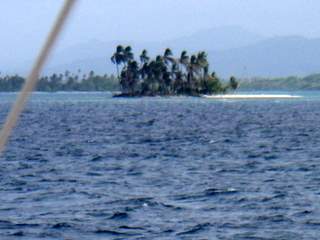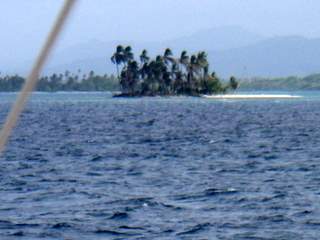2010- WARC, week 2

Tucanon
Dick and Irene Craig
Fri 15 Jan 2010 16:23
During the afternoon of the second day out of St Lucia, the blow from a whale was spotted fifty metres off the starboard bow then, within less than a minute, a second blow. We were also lucky enough to see on Friday afternoon, a blow some 100 metres off the starboard hull. This was twice as big as those seen previously and twice the size. It caught the light, despite the sky being full of clouds and the effect, although not a rainbow, had colour. It is impossible to identify which colours they were but there is no doubt that they were there.
Saturday night as we approached the coast of Columbia, several ships passed us by on either side, going in both directions, although the closest we sailed to them was just less than four nautical miles.
Sunday morning we were sailing about 55 nautical miles off the coast of Columbia, in a south westerly direction. ETA at the finish line for this leg is currently during the hours of darkness on the 12th January. We have been advised not to enter these narrow, deep channels other than during the morning hours when the sun is from the right direction and not when it is cloudy.
Without the parasailor, we have no chance of increasing our speed by very much so it will probably be necessary for us to slow down, or just sail back and forth until daylight.
The back of the sailbag has come out of the runners along the boom, as has a large section on the port side. We need to take it out of the runners completely and rethread it. At present it is supported with the additional help of some ropes.
Lunch yesterday was pizza and supper Jerk chicken with black-eyed peas, then pancakes with real maple syrup. Yum, yum!
Saturday the seas were pretty big and the odd wave found its way over the stern port quarter. When I came on watch that morning, a flying fish had committed suicide and was lying beside the slightly open hatch on the port stern.
The seas became bigger and the wind was force 7 and force 8. Unbelievably, in these rough seas, a couple of flasks fell off a work surface in the galley. A plate, still resplendent with beef bourguignon, casually put down, ended upon the floor and the plate was broken. In the three years that we have sailed this boat, this is the first time that anything other than a pamphlet has even moved.
We put 2 reefs in the mainsail and 1 in the genoa but eventually, just to steady the boat, on Monday we took down the mainsail and sailed under the full genoa.
The noise as the boat sailed through the rough seas was not conducive to sleep.
Bob sat in the cockpit reading and a six metre wave, breaking over the back of the boat, soaked him.
Tuesday morning when I came on watch the sea was not quite as big, though it was still rough. However, the wind was gusting no more that 28knots. I requested that we raise the mainsail which was duly done, after first consulting with the Captain that this was OK.
We had not been travelling at a speed which would enable us to arrive during daylight hours. Raising the mainsail helped the boat sail faster against the 2knot current and gave us hope that we would reach the finish line during daylight hours.
The sky was very cloudy all day, from the time it became light until night fell, so we had to approach the San Blas Islands under cloud.
Oisin spotted land ten nautical miles from the finish line and Bob spotted the first of the islands five miles further in.
We crossed the finish line of the leg to San Blas at 14.41.50 on Tuesday, 12th Jan although it was 17.14 by the time we had made our way through the channels to the anchorage, already occupied by about 18 other sailing boats and set our anchor behind Green island.
The first place that we dropped the anchor was, unknown to us, very close to a reef which is above the water level at low tide. An Irishman came across in his dingy and advised us of the fact. Later, we heard him talking to one of the other boats over the VHF, describing how he "saved the boat of these English plonkers who were about to anchor next to a reef".
We raised the anchor and moved to a different part of the anchorage where, after several more attempts, we finally set the anchor.
The rib was lowered into the water and Bob, Pili and Oisin, armed with wine and beer, made their way ashore to join a party on the beach while Dick and I remained aboard on anchor watch.
There are 378 islands within the archipelago of the San Blas islands, about forty nine of which are inhabited. Run as an autonomous province by the Kuna Indians there is little interference from the government of Panama.
Next morning, the sky was still cloudy though the sun did shine through from time to time. We swam in the blue, warm water though the clarity was not good and we didn't see any fish. Dick measured the water temperature using a hand held thermometer and calibrated the instruments to read 29º centigrade.
The islands which we visited were heavily wooded with palm trees and apparently each coconut, whether it is on a tree or on the ground, belongs to one of the Kuna indians.
On one corner of an island close to our anchorage, several laurels were growing and had, in one place, formed a thick hedge.
Sadly, there was a great deal of rubbish on the islands. Some had probably been washed up there but it was obvious that a lot had just been left there. Empty drinks cans and other refuse were still in evidence from bonfires which had been lit but had burnt out before consuming the detritus.
There were so many shoes among the jet-sum and flot-sum that one could have opened a shoe shop for unidexters.
On Thursday morning, A large wooden canoe stopped at our boat and we were able to purchase from them 3 tuna, providing sufficient food for two meals for five people, at a cost of only $3 US.
We left the anchorage at Green island to sail to Barbecue island. As we made our way out of the anchorage, the depth gauge suddenly read 0.8 of a metre. Dick reversed quickly and steered away from the shallows and was soon in 30 metres of water.
We found a perfect spot in beautiful blue water, just behind an island which protected us from the wind. The anchor set first time and we were soon swimming.
Late afternoon we were approached by another big, wooden canoe containing six small children, three teenage children and two male adults. One of the adults, drinking from a can of beer he had obtained from one of the other boats at anchor, asked us for $10 US to anchor in the waters around San Blas. We paid the money and he gave us a receipt which should cover us from having to pay the charge again.
The attached photo's are:
Desert island as we approach our anchorage at Green island and Dick and Oisin jamming in the cockpit while at anchor at Green island

